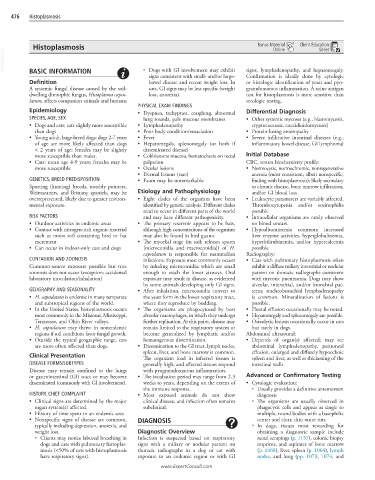Page 969 - Cote clinical veterinary advisor dogs and cats 4th
P. 969
476 Histoplasmosis
Histoplasmosis Bonus Material Client Education
Sheet
Online
VetBooks.ir
○ Dogs with GI involvement may exhibit
BASIC INFORMATION
signs consistent with small- and/or large- signs, lymphadenopathy, and hepatomegaly.
Confirmation is ideally done by cytologic
Definition bowel disease and recent weight loss. In or histologic identification of yeast and pyo-
A systemic fungal disease caused by the soil- cats, GI signs may be less specific (weight granulomatous inflammation. A urine antigen
dwelling dimorphic fungus, Histoplasma capsu- loss, anorexia). test for histoplasmosis is more sensitive than
latum; affects companion animals and humans serologic testing.
PHYSICAL EXAM FINDINGS
Epidemiology • Dyspnea, tachypnea, coughing, abnormal Differential Diagnosis
SPECIES, AGE, SEX lung sounds, pale mucous membranes • Other systemic mycoses (e.g., blastomycosis,
• Dogs and cats; cats slightly more susceptible • Lymphadenopathy cryptococcosis, coccidioidomycosis)
than dogs • Poor body condition/emaciation • Protein-losing enteropathy
• Young adult, large-breed dogs; dogs 2-7 years • Fever • Severe infiltrative intestinal diseases (e.g.,
of age are more likely affected than dogs • Hepatomegaly, splenomegaly (or both if inflammatory bowel disease, GI lymphoma)
< 2 years of age; females may be slightly disseminated disease)
more susceptible than males. • Cobblestone mucosa, hematochezia on rectal Initial Database
• Cats: mean age 4-9 years; females may be palpation CBC, serum biochemistry profile:
more susceptible • Ocular lesions • Normocytic, normochromic, nonregenerative
• Dermal lesions (rare) anemia (most consistent, albeit nonspecific,
GENETICS, BREED PREDISPOSITION • Exam may be unremarkable finding with histoplasmosis); likely secondary
Sporting (hunting) breeds, notably pointers, to chronic disease, bone marrow infiltration,
Weimaraners, and Brittany spaniels, may be Etiology and Pathophysiology and/or GI blood loss
overrepresented, likely due to greater environ- • Eight clades of the organism have been • Leukocyte parameters are variably affected.
mental exposure. identified by genetic analysis. Different clades Thrombocytopenia and/or eosinophilia
tend to occur in different parts of the world possible
RISK FACTORS and may have different pathogenicity. • Intracellular organisms are rarely observed
• Outdoor activities in endemic areas • The primary reservoir appears to be bats, on blood smears.
• Contact with nitrogen-rich organic material although high concentrations of the organism • Hypoalbuminemia common; increased
such as moist soil containing bird or bat may also be found in bird guano. liver enzyme activities, hyperglobulinemia,
excrement • The mycelial stage (in soil; releases spores hyperbilirubinemia, and/or hypercalcemia
• Can occur in indoor-only cats and dogs [microconidia and macroconidia]) of H. possible
capsulatum is responsible for mammalian Radiography:
CONTAGION AND ZOONOSIS infections. Exposure most commonly occurs • Cats with pulmonary histoplasmosis often
Common-source exposure possible but true by inhaling microconidia, which are small exhibit a diffuse miliary interstitial or nodular
zoonosis does not occur (exception: accidental enough to reach the lower airways. Oral pattern on thoracic radiographs consistent
laboratory inoculation/inhalation) exposure may result in disease, as evidenced with mycotic pneumonia. Dogs may show
by some animals developing only GI signs. alveolar, interstitial, and/or bronchial pat-
GEOGRAPHY AND SEASONALITY • After inhalation, microconidia convert to terns; tracheobronchial lymphadenopathy
• H. capsulatum is endemic in many temperate the yeast form in the lower respiratory tract, is common. Mineralization of lesions is
and subtropical regions of the world. where they reproduce by budding. possible.
• In the United States, histoplasmosis occurs • The organisms are phagocytosed by host • Pleural effusion occasionally may be noted.
most commonly in the Missouri, Mississippi, alveolar macrophages, in which they undergo • Hepatomegaly and splenomegaly are possible.
Tennessee, and Ohio River valleys. further replication. At this point, disease may • Osteolytic lesions occasionally occur in cats
• H. capsulatum may thrive in nonendemic remain limited to the respiratory system or but rarely in dogs.
regions if soil conditions favor fungal growth. become generalized by lymphatic and/or Abdominal ultrasound:
• Outside the typical geographic range, cats hematogenous dissemination. • Depends of organ(s) affected; may see
are more often affected than dogs. • Dissemination to the GI tract, lymph nodes, abdominal lymphadenopathy, peritoneal
spleen, liver, and bone marrow is common. effusion, enlarged and diffusely hypoechoic
Clinical Presentation The organism load in infected tissues is spleen and liver, as well as thickening of the
DISEASE FORMS/SUBTYPES generally high, and affected tissues respond intestinal walls
Disease may remain confined to the lungs with pyogranulomatous inflammation.
or gastrointestinal (GI) tract or may become • The incubation period may range from 2-3 Advanced or Confirmatory Testing
disseminated (commonly with GI involvement). weeks to years, depending on the extent of • Cytologic evaluation:
the immune response. ○ Usually provides a definitive antemortem
HISTORY, CHIEF COMPLAINT • Most exposed animals do not show diagnosis
• Clinical signs are determined by the major clinical disease, and infection often remains ○ The organisms are usually observed in
organ system(s) affected. subclinical. phagocytic cells and appear as single to
• History of time spent in an endemic area multiple, round bodies with a basophilic
• Nonspecific signs of disease are common, DIAGNOSIS center and clear, thin outer rim.
typically including depression, anorexia, and ○ In dogs, tissues most rewarding for
weight loss. Diagnostic Overview obtaining a diagnostic sample include
○ Clients may notice labored breathing in Infection is suspected based on respiratory rectal scrapings (p. 1157), colonic biopsy
dogs and cats with pulmonary histoplas- signs with a miliary or nodular pattern on imprints, and aspirates of bone marrow
mosis (<50% of cats with histoplasmosis thoracic radiographs in a dog or cat with (p. 1068), liver, spleen (p. 1064), lymph
have respiratory signs). exposure to an endemic region or with GI nodes, and lung (pp. 1073, 1074, and
www.ExpertConsult.com

